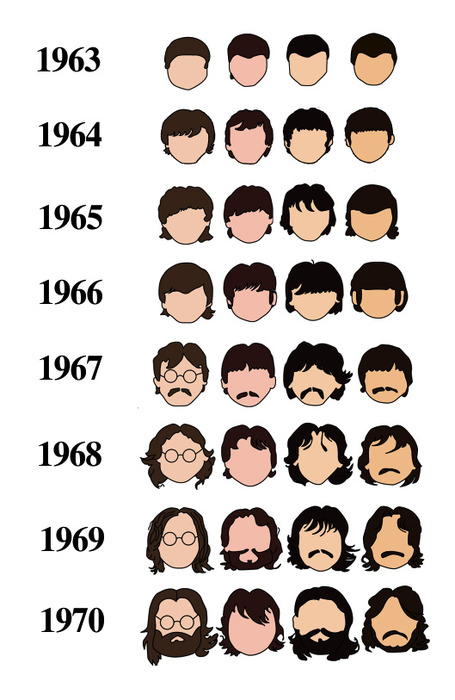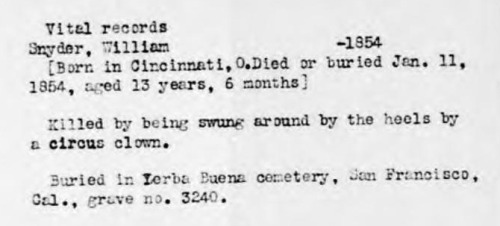Mary Poppins is a witch. The truth has been sugar coated for too long. Ten million people have seen this video on YouTube and now know the truth. Are you one of them?
Author: Nathan Campbell
Classic film scores: now with vuvuzela
If you’re missing the vuvuzela like I am then you’ll no doubt appreciate this video.
The cost of anti-piracy success
The recording industry is notoriously harsh on music pirates. They’ve pursued individuals with almost no sense of mercy or having a punishment that fits the crime (I’m not condoning piracy here – I think creative people are worth their keep). And it’s little wonder when you read a factoid like this, about the Recording Industry Association of America’s legal costs when compared to their “wins”:
“…they [the RIAA] spent around $64,000,000 in legal and investigative expenses to recover around $1,361,000.”
That’s throwing good money after bad.
More on Dunning-Kruger: the gap between confidence and competence
A few weeks ago I posted a brief mention of the Dunning-Kruger effect – a psychological phenomena whereby the victim does not realise they are too dumb to know what they don’t know… or something like that. This is a great interview with the Dunning from Dunning-Kryger:
If you knew it, you’d say, “Wait a minute. The decision I just made does not make much sense. I had better go and get some independent advice.” But when you’re incompetent, the skills you need to produce a right answer are exactly the skills you need to recognize what a right answer is. In logical reasoning, in parenting, in management, problem solving, the skills you use to produce the right answer are exactly the same skills you use to evaluate the answer. And so we went on to see if this could possibly be true in many other areas. And to our astonishment, it was very, very true.
And here’s a funny story illustrating the issue (which will doubtless make a good sermon illustration)… from the same article.
“Wheeler had walked into two Pittsburgh banks and attempted to rob them in broad daylight. What made the case peculiar is that he made no visible attempt at disguise. The surveillance tapes were key to his arrest. There he is with a gun, standing in front of a teller demanding money. Yet, when arrested, Wheeler was completely disbelieving. “But I wore the juice,” he said. Apparently, he was under the deeply misguided impression that rubbing one’s face with lemon juice rendered it invisible to video cameras.
In a follow-up article, Fuoco spoke to several Pittsburgh police detectives who had been involved in Wheeler’s arrest. Commander Ronald Freeman assured Fuoco that Wheeler had not gone into “this thing” blindly but had performed a variety of tests prior to the robbery. Sergeant Wally Long provided additional details — “although Wheeler reported the lemon juice was burning his face and his eyes, and he was having trouble (seeing) and had to squint, he had tested the theory, and it seemed to work.” He had snapped a Polaroid picture of himself and wasn’t anywhere to be found in the image. It was like a version of Where’s Waldo with no Waldo. Long tried to come up with an explanation of why there was no image on the Polaroid. He came up with three possibilities:
(a) the film was bad;
(b) Wheeler hadn’t adjusted the camera correctly; or
(c) Wheeler had pointed the camera away from his face at the critical moment when he snapped the photo.[2]
As Dunning read through the article, a thought washed over him, an epiphany. If Wheeler was too stupid to be a bank robber, perhaps he was also too stupid to know that he was too stupid to be a bank robber — that is, his stupidity protected him from an awareness of his own stupidity.”
This (the Devil) is why you’re fat: update
You might be wondering where part two of my book review is. And so am I. More correctly, I’m wondering where the book is. I can’t find it. Maybe the devil stole it.
I’ll keep you posted. Hopefully.
In the meantime, enjoy this profound spam comment left on my last post:
“Think of how retarded the average guy is, and realize halve of them are stupider than that.”
The cult of Mac
Some people take their Mac fetish to a spiritual level – and it seems with good reason. There’s probably a conspiracy theory book in this. Apple has styled itself as a religion. Maybe.
Here are some potential “religious elements” identified in an interesting study, covered in this article from the Atlantic, entitled: “How the iPhone Became Divine: New Media, Religion and the Intertextual Circulation of Meaning“, it followed an earlier study on “The Cult of Macintosh.”
- a creation myth highlighting the counter-cultural origin and emergence of the Apple Mac as a transformative moment;
- a hero myth presenting the Mac and its founder Jobs as saving its users from the corporate domination of the PC world;
- a satanic myth that presents Bill Gates as the enemy of Mac loyalists;
- and, finally, a resurrection myth of Jobs returning to save the failing company…”
The scholar responsible for that article summed up the Apple experience:
“When you’re buying into Mac, you’re buying into an ideology. You’re buying into a community.”
It’s funny. In a day and age where the church is trying to figure out how to learn from Apple, Apple seems to have flipped the metaphorical apple cart – in basing its business practices on the church.
Real Life Super Heroes Redux
I haven’t seen Kick-Ass yet. But real life vigilante Super Heroes are pretty cool in a “don’t try this at home,” “what you’re doing is illegal and stupid” kind of way. You’ll find a bunch of Real Life Super Hero posts around these parts (check the tag below). Here’s a story about a little posse of heroes that covers the basic elements for your gang. If you do want to start one. Which you shouldn’t.

Z is the enforcer. His bedroom just has weights, a punching bag, and a mattress.
Victim is the gadget man. He’s based out of town so operates a bit like Q from the Bond movies – shipping in gadgets and technology and scientifically tested armour.
Zimmer is the medic. He also wears a blindingly bright light, Iron Man style, as part of his costume. He uses it to stun would be assailants.
Tsaf is the group’s girl power. Her name is “fast” backwards.
Lucid is extra muscle.
Lucy the kitten is their animal mascot
They wear costumes:
“Z sits down and begins strapping on his full body armor, a homemade medley of leather, pads and stainless steel bits and pieces, which he describes as a “poor man’s Iron Man suit.” The suit includes boots, leg, knee and ankle pads. A pair of arm bracers he made out of leather and steel are attached to his arms with truck ties and work as both defense and offense. To complete the look, he wears a black Predator-type mask sure to creep out anyone who sees it on the street. He then puts on his “butcher mail,” a stab-proof apron of metal scales over a lightweight bulletproof vest, which he then covers with a sleeveless, brownleather zip-up.”
Functional costumes – no aesthetic but impractical spandex.
“Everything I wear is either protective gear or to blend in during plainclothes patrols, with gear underneath. No spandex. Ever,” Z explains. “If I ever wear spandex, I deserve to get shot down in the street like the dumbass that I am.”
By night they patrol the streets – essentially hoping to entrap bad people into doing bad things in their presence.

“The strategy is that Z will skate ahead on a longboard, a sturdy, fast skateboard made for cruising. The longboard is also a good excuse to be wearing a lot of protective gear. Next in the lineup is the bait (described as the “nucleus” of the patrol)—usually TSAF or Zimmer. In tonight’s case, TSAF wears a white dress, purple eye makeup and is carrying a bulky purse. She tries to lure predators looking for someone vulnerable. Zimmer follows on foot about a block behind her.
Lucid, if he were here, would act as a runner, skating back and forth on his longboard between the group members as they move forward. TSAF watches for Z; Zimmer watches for TSAF; and Lucid would be watching everyone. Communication is vital: All parties are connected by cell phone, ready to leap into action if anything happens.”
The Beatles in hair
The Beatles evolved throughout their career – their music changed. And so did their hair.

Via Flowing Data.
Colour me colrouphobic: attack of the killer clown
Here’s one to stoke your (largely rational) fear of clowns.

“Killed by being swung around by the feet by a circus clown”
From the California Biographical Collection Burial Records, via here.
How to learn Greek and Hebrew on the Mac
Step one: Download Paradigmatic – a great resource for college students by a college student (now former college student).
I’ve only grabbed it today, but it comes highly recommended by people in the know.
Sam Freney, the whizz in question, has also produced a Greek lexicon for the iPhone available here, or via iTunes.
Two truly terrific resources. Grab them today. They’re probably worth getting a Mac for (if you’ve been trying to justify a purchase).
How to write funny comics
Calvin and Hobbes creator Bill Watterson responded to a piece of fan mail with these tips on creating funny comic strips. He’d know.

Here are the tips.
1. Materials are not important, so long as your work reproduces and reduces clearly. It’s what you do WITH the materials that counts.
2. I think characters are more important than jokes. Any cartoonist ought to be able to come up with funny gags, but the best strips have rounded, complex characters that readers can care about. Cartoon characters should be more than standing props to deliver jokes.
3. Don’t imitate other strips. Editors are looking for something new and original.
4. Most importantly, have fun with your work, and practice writing and drawing all you can.
Via Letters of Note.
How to pick a church slogan
If you’re in the business of picking church slogans you don’t want to go cherry picking passages willy-nilly. The U.C.C is not famous for caring what the Bible actually says, so it could well be that they were aware that these words actually come from the mouth of Satan when he’s tempting Jesus in the desert.

The tagline reads “if thou therefore will worship me, all shall be thine – Luke 4:7″…
Luke 4:7 in context reads:
5The devil led him up to a high place and showed him in an instant all the kingdoms of the world.6And he said to him, “I will give you all their authority and splendor, for it has been given to me, and I can give it to anyone I want to. 7So if you worship me, it will all be yours.”
8Jesus answered, “It is written: ‘Worship the Lord your God and serve him only.’
I reckon verse eight is a better starting point.
Via Nathan Bingham.
What do you get when you mix nerds and heretics?
As earlier reported, the Westboro Baptists picketed a comic convention this week. Which is pretty dangerous territory.

They fought signs with signs.


Typographic moustaches
If you want to make a type-face and need a good type-moustache here’s a handy guide to the moustaches produced by flipping the curly brackets ({) from popular fonts.

From here. You can buy it as a poster.